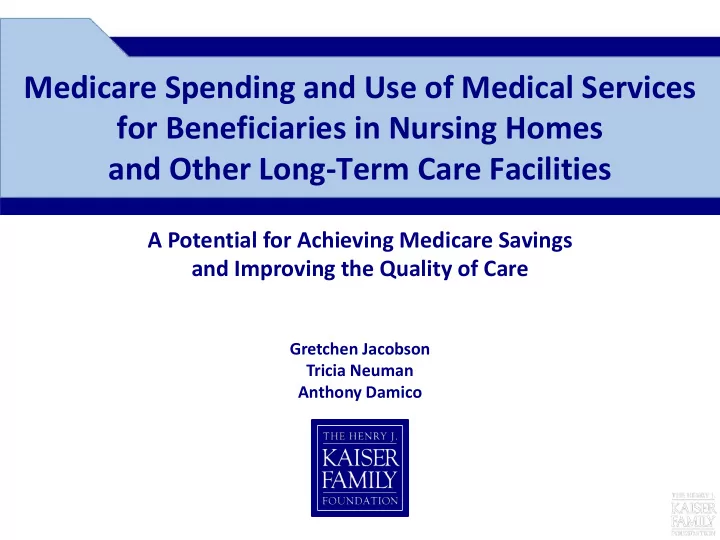

EXHIBIT 0 Medicare Spending and Use of Medical Services for Beneficiaries in Nursing Homes and Other Long-Term Care Facilities A Potential for Achieving Medicare Savings and Improving the Quality of Care Gretchen Jacobson Tricia Neuman Anthony Damico
EXHIBIT 1 Average Per Capita Medicare Spending is More Than Double for Beneficiaries in Long-Term Care Facilities than for Others $14,538 $6,726 Long-Term Care Community Facility Residents Residents Number of 1.7 million 33.5 million beneficiaries NOTE: Excludes Medicare Advantage enrollees’ spending. Excludes Medicare prescription drug spending. SOURCE: Kaiser Family Foundation analysis of the Medicare Current Beneficiary Survey Cost & Use File, 2006.
EXHIBIT 2 Beneficiaries Living in Long-Term Care Facilities Have High Rates of Hospitalizations, ER Visits and Other Medicare-Covered Events Percent of beneficiaries with at least one Medicare-covered: Emergency Room 51% Visit Hospital Visit 38% Skilled Nursing 27% Facility Stay Hospice Event 14% Home Health Visit 9% NOTE: Includes beneficiaries who were in long-term care facilities as of January 1, 2006, including those who died before the end of 2006. Excludes Medicare Advantage enrollees. Excludes Medicare prescription drug spending. SOURCE: Kaiser Family Foundation analysis of the Medicare Current Beneficiary Survey Cost & Use Files, 2006.
EXHIBIT 3 Beneficiaries in Long-Term Care Using ER, Hospital, or SNF Services Often Have Multiple Events 1 event only 1 event only 2+ events 2+ events 51% have 1 or more ER visits 25% 26% ER visits Half have 2 or more visits 38% have 1 or more hospitalizations Hospital visits 22% 16% Average Number of Inpatient Days, 2006: 13 days 41% are readmitted 27% have 1 or more SNF stays SNF stays 17% 10% Average Number of SNF Days, 2006: 40 days 36% have 2 or more SNF admissions NOTE: Includes beneficiaries who were in long-term care facilities as of January 1, 2006, including those who died before the end of 2006. Excludes Medicare Advantage enrollees’ spending. Excludes Medicare prescription drug spending. SNF is skilled nursing facility. ER is emergency room. SOURCE: Kaiser Family Foundation analysis of the Medicare Current Beneficiary Survey Cost & Use Files, 2006.
EXHIBIT 4 Hospitalizations Account for the Largest Share of Medicare Spending for Long-Term Care Facility Residents, 2006 Other $20,592 Hospice 1% Home health Outpatient visits 13% Medical provider/DME 1% SNF stays 8% Inpatient hospital $14,538 13% 1% 10% $11,984 3% 1% 11% 17% 8% 5% 18% 13% 21% 19% 20% 48% 39% 32% Total Survivors Decedents Beneficiaries in long-term care facilities 1.7 million 1.2 million 0.5 million as of January 1, 2006 NOTE: Includes all beneficiaries in long-term care facilities as of January 1, 2006, including those who died before the end of 2006. Excludes Medicare Advantage enrollees’ spending. Excludes Medicare prescription drug spending. SOURCE: Kaiser Family Foundation analysis of the Medicare Current Beneficiary Survey Cost & Use Files, 2006.
EXHIBIT 5 Potential for Medicare Savings • Research by others suggests between 30 and 67 percent of hospitalizations for long-term care facility residents are potentially preventable • Conservatively, we estimate potential Medicare savings of least $2.1 billion in 2010 if hospitalizations were reduced by 25% • Does not include reductions in spending associated with reductions in others services, such as post-hospital SNF admissions, ER visits or ambulance costs • Would likely produce additional some savings for Medicaid – to the extent that Medicaid incurs costs associated with medical care • Does not take into additional (unknown) costs associated with interventions • Delivery system reforms that focus on long-term care facility residents have potential to improve the quality of patient care and reduce Medicare spending
Recommend
More recommend